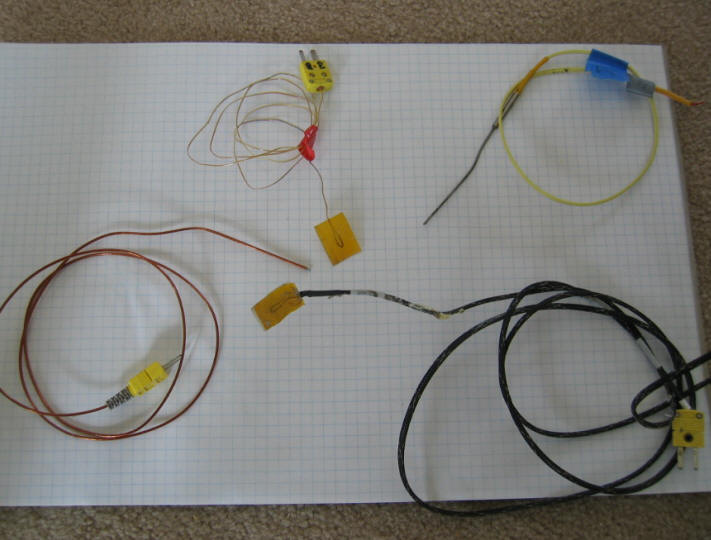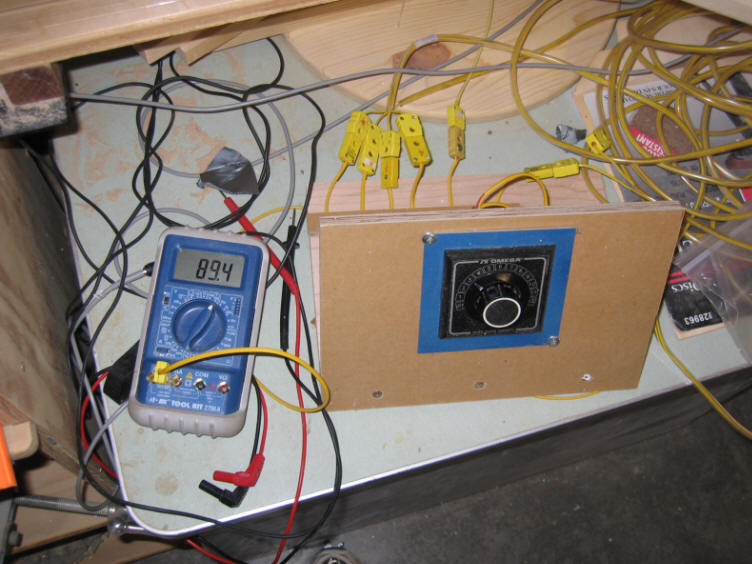
Search
The Renewable Energy site for Do-It-Yourselfers
Using Thermocouples
|
When two different metals are joined,
a voltage is generated across the junction, and the voltage depends on the
temperature of the junction. A thermocouple uses this voltage to measure
temperature. The voltage is small, and the relationship of the voltage to
temperature is not linear, so special circuitry is required to determine the
temperature.
Some of the things that I think
thermocouples work well for in the solar thermal world are:
-
Measuring high temperatures --
several hundred degrees is no problem
-
Fast reaction time -- low thermal
mass thermocouples react to changes in temperature very fast
-
Surface temperatures -- low mass,
stick on thermocouples measure surface temperatures accurately (Placing A tiny patch
of insulation over the TC keeps in from reacting to the surrounding air)
-
Depending on the type of head on
the TC, they are pretty rugged and will stand some abuse.
|
|
On the down side, they typically
don't have the accuracy of Thermistors -- getting +-1F takes a fair bit of
attention to detail.
Thermocouples come in several basic
types depending on the particular two metals that they use. There are K, J,
N, T, E and probably more thermocouples. Each of these types uses a
different metal pair to generate the temperature dependant voltage. Each
of these types has its own strong a weak points, but for most part any of them
will work for the range of temperatures and conditions encountered in solar
thermal work. Since each of these types requires unique wire type,
connectors, and measuring equipment, it can be expensive to use a mix of
different types of thermocouples. Best to standardize on one type.
The most common and best supported type of thermocouple is the K. J
thermocouples are also well supported.
Thermocouples come with a wide
variety of junction ends. The cheapest is just a small bulb of material
where the two wires join -- these work for a wide variety of circumstances in
solar thermal work. Another form has a protective metal sheath over the
junction to protect it from harsh environments. Another useful
configuration has a sort of flattened end that is embedded in an adhesive pad --
these are good for measuring surface temperatures -- just stick them on.
Thermocouples with low mass junctions that have a lot of surface area are also
available, and react very quickly to temperature changes.

Picture shows thermocouples -- CW
from lower left: 1)
simple bead junction, 2) adhesive pad surface mount, 3) a metal sheathed
junction, and 4) another surface mount adhesive pad. These are all K type
thermocouples -- you can tell this from the yellow connector color.
While the thermocouples themselves
are not to expensive (5 packs for $50ish), the connectors, extension wires, and
the meter with the measuring circuitry all add up -- so make sure you add up
the full cost of the system before committing to thermocouples.
I use the setup shown below to
measure the output from up to 10 thermocouples at a pretty low total price.

The meter is just an ordinary
multi-meter that measures voltage, resistance just as all multi-meters do, but
it also
has a socket for a K type thermocouple and provides two scales for
measuring temperature. This adds very little to the cost of the
multi-meter, and many of the multi-meters made today come with the feature.
In order to easily measure
temperatures from multiple thermocouples without having to plug and unplug them
all the time, I use a thermocouple switch which will accept inputs from up to 10
thermocouples, and depending on the switch position, connect only one of them to
the meter at a time. The switch is made specifically to switch thermocouples
-- an ordinary rotary switch will introduce error. The switches can
be purchased from Omega.com or other places that handle thermocouple equipment.
They also seem to come up on ebay fairly often.
Many other thermocouple reading
meters and loggers are available. There are a number of 1 and 2
thermocouple meters that are fairly inexpensive -- some of them have some data
logging capability. There are also some electronic kits available that can
be used in front of data loggers to convert the TC output to a more normal data
logger AD voltage range. On the high end, you can spend many thousands of
dollars on lab quality thermocouple loggers.
The extension cords to allow the
thermocouple to be placed some distance from the meter are different for each
type of thermocouple, and are expensive (a good reason to standardize on one TC
type). These tend to come up on ebay once in a while at more
reasonable prices. The same logic applies to the connectors.
Calibrating:
If its not terribly critical to get
very accurate measurements, then at the start of the project, I bring all the
thermocouples to the same area, and hook them up to the meter via the switch.
I tie them together, and give them time to come to the same temperature.
I then see what each one is reading on the meter -- if any of them are too far
off, I replace them.
If more accuracy is needed, you can
use the ice bath and boiling water procedure to calibrate them. This is
pretty time consuming. If you have an accurate thermometer, you can use it
to calibrate the TCs at one or more temperatures.
Sources:
Thermocouples and thermocouple
equipment (meters etc.) are available from a wide variety of places.
Electronics supply places like DigiKey sell multimeters that read
thermocouples. I buy most of my stuff from Omega.com -- they have
competitive prices and don't mind small orders. I'm sure that there are
many other good suppliers out there. Ebay often has thermocouple related
equipment, and you can find some good deals, BUT, I have seen TC stuff sell for
more on ebay than they you can buy the same item for new at retail. You
also need to be very, very certain about what you are getting.
Gary Updated Oct 10, 2007
